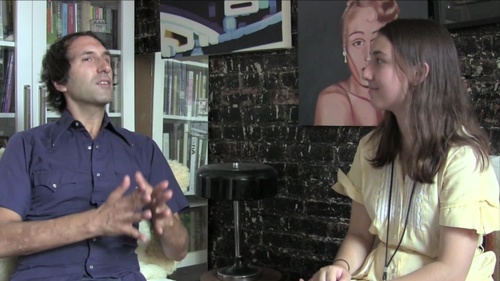Nick Hallett: Voice & Light Systems, Part Two: Karlheinz Stockhausen’s Stimmung
Nick Hallett—singer, composer, and downtown impresario—creates a four-part series, as part of New Museum’s newly launched RE:NEW RE:PLAY Performance Residency Series, at the Museum’s theater connecting the human voice to multimedia ritual.
Hallett’s monthlong residency continued with a performance of Karlheinz Stockhausen’s Stimmung. Composed in 1968 for the Collegium Vocale Köln, the work was performed by a new vocal group including Hallett along with the singers Gisburg, Silvie Jensen, Robert Osborne, Daisy Press, and Peter Sciscioli; audio design for this concert was by Dafna Naphtali, with assistance from Joseph Mariglio. Stimmung was structured around various permutations (named “models” in the composer’s instructions) of a B-flat ninth chord, designed to elicit harmonic overtones (the combination of resonanting frequencies in perceived pitch). Inspired by his travels to Mexico, Stockhausen’s work incorporated the invocation of a pan-global collection of deities and erotic poetry into a seventy-five-minute treatise on tuning minutiae. The group performed in a circular formation around an illuminated altarpiece created by Brock Monroe and Joshua White.
In collaboration with a rotating cast of performers and artists, Hallett presented original music and performance alongside new interpretations of celebrated vocal works by Meredith Monk and Karlheinz Stockhausen. The singing voice was seen here in its rawest state, stripped of its language-based sensibilities, and more as a flexible instrument of sound, capable of producing protosemantic, acoustic phenomena. As such, concepts of drone, repetition, and improvisation prevail over the tropes of traditional song. Each evening was staged using pure light, illuminated objects, and projection methods derived from structuralist film and the psychedelic lightshow to create a live, interdisciplinary synthesis of sound and image. Taking from John Cage’s maxim that “art should not be different than life, but an action within life,” “Voice & Light Systems” revisited the Zen-Buddhism-inspired methodologies popular among Western artists during the 1960s and ’70s as ritual practices in and of themselves, envisioning their scores much as sacred texts in a pre-literary culture, to be rendered as expressions of devout “art consciousness.” With this experimental tradition as a starting point, Hallett began to develop new work for contemporary contemplation, with the voice—the most basic instrument of artistic expression—at its core.
